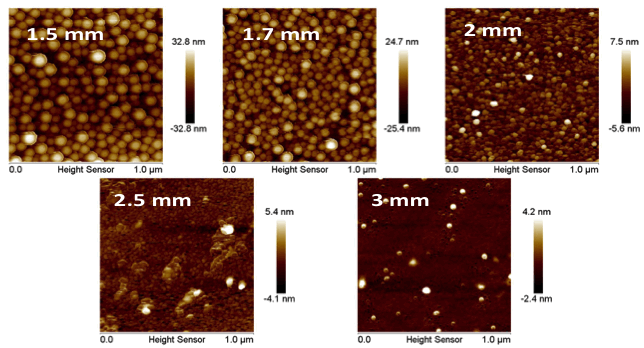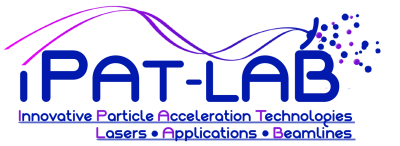The enhancement and control of growing techniques for nanomaterials, in particular nanocrystals, is one of the current key challenges in nanoscience and nanotechnology. Nanomaterials are of strong importance in many fields, ranging from material science (mechanics), energy production (nuclear plants), medicine (surgery and bioimaging) and aero spatial application[1] [2] which all together represent today a market value that exceeds the 5B$ value with a two digit percent increase. The great interest in these new materials is not only related to their properties and potential applications but that many properties can be tuned by tailoring the size, shape, surface functionality or crystallinity of the nanocrystals[3].
The control of nanocrystals synthesis is currently in an embryonic state. Empirical procedures have been developed for the preparation of a wide range of semiconductor, ceramic, and metallic nanocrystals and the methods and growth parameters are often very specific to a single research group. There are two main synthesis processes, chemical reactions and physical processing. Chemical nanocrystals synthesis (and of nanomaterials in general) is highly sensitive to experimental parameters, e.g. pH, precursors, temperature, time, capping agent and the variation in these parameters can strongly influence the properties of grown samples[4],[5],[6],[7],[8]. For example, changes in temperature or time conditions can dramatically modify the shape and dimensions of the produced nanomaterials and therefore the roughness of nanostructured surfaces, preventing insertion in electronic devices (high roughness causes high contact resistance) or can change their mechanical properties, e.g., heat conduction, mechanical resistance. For long reaction times (> ms), the Ostwald – ripening mechanism becomes effective and large amorphous aggregates (~ few microns) appear in the solution, broadening the size distribution and the quantum size confinement effect (dimension < 10 nm) is completely lost. Chemical methods cause the intrinsic formation of a surfactant shell around the nanoparticles/nanostructures, which strongly influences the electronic properties e.g., the band edge.
“Chemical-free” methods based on a physical process, including Pulsed Laser Deposition (PLD), the ionic and electronic lithography (i.e. Focused Ion Beam (FIB) or the Laser Ablation in Solution (LASiS)), are often used for the realization of metal nanoparticles. However, laser-based synthetic processes for insulators and semiconductors nanostructures have barely been studied and implemented, due to the difficulty in obtaining uniform nanoparticles from a bi-atomic, or multi-atomic target. High-energy UV lasers or ion beams, in controlled atmosphere or in vacuum, ablate material from a target’s surface and form a high energetic plasma plume. Under these conditions, the irradiation causes the evaporation of high energetic atoms, molecules and clusters from the target, which upon impacting the substrate, aggregate randomly, forming nanoparticles of various atomic and molecular species without a precise controllable crystal shape[9]. To date, achieving fine control over the monodispersivity, structure, composition and defects of nanocrystals is still a major challenge in nanotechnology that many research groups are pursuing and that is considered strategically important for manifold applications. The main problem in the definition of a standard growth protocol is the individuation of parameters to generate the conditions of temperature and pressure required to produce well-defined structures in very short timescales (ps-fs), necessary for the nucleation of particles with dimensions of tens of nm.
A way to achieve this is the irradiation of matter, in vacuum or in solution, by an energetic proton beam with short duration. The irradiation of a bulk target by high energetic particles (in particular protons) can generate the temperature and pressure conditions required to grow crystalline structure, while the short pulse duration limits the nucleation time to the range of ps-ns ensuring the stop of nucleation at crystallinity phase without aggregation of amorphous structures.

Nanocarpets generated by laser-driven protons at different radial distances from the center of the impinging proton beam
Ultra-intense high-energy short laser pulses, produced by interaction of a short-pulse (duration 1018 W/cm2) laser with a solid target, enable the production of multi-MeV proton beams that have a very short duration (ps at the source), high energy (up to tens of MeV), high flux (about 1012 protons/cm2), high laminarity[10] and have a great potential for novel applications[11],[12], [13], [14], [15]. The intrinsic properties of protons to very locally deposit energy (Bragg peak) enables a very short and quick heating of the irradiated samples and the generation in the bulk sample, temperature and pressure conditions that are unreachable in conventional nanomaterial laboratories[16], [17]. The short bunch length of the laser-generated protons (typically ps at the source) can limit the nanoparticle growth time to a few ns, thus stopping the amorphous nucleation of larger (hundreds of µm) particles much faster than any conventional technique[18].
The objective of this research activity is to use laser-generated protons to grow and obtain nanostructured surfaces where the constituent nanomaterials are nanocrystals with well-defined shape, dimensions and crystallinity.
[1] F. Wang, V. N. Richards, S. P. Shields, W. E. Buhro, Chemistry of Materials, 26, 5 (2014)
[2] S. E. Lohse, N. D. Burrows, L. Scarabelli, L.M. Liz-Marzan, C.J. Murphy, Chemistry of Materials, 26, 34-43 (2014)
[3] Lian-Yi Chen A., Xu Jia-Quan, Choi H, Hiromi Konishi, Song Jin, Xiao-Chun Li, Rapid control of phase growth by nanoparticles, Nature Communications 5, 3879 (2014)
[4] Fan F.J., Wu L., Yu S. H., Energetic I–III–VI2 and I2–II–IV–VI4 nanocrystals: synthesis, photovoltaic and thermoelectric applications, Energy Environmental Science 7, 190 (2014)
[5] Baumgartner J., Dey A., Bomans P. H. H., Le Coadou C., Fratzl P., Sommerdijk N. A. J. M., Faivre D., Plasmon–Exciton Interactions in Hybrid Structures of Au Nanohemispheres and CdS Nanowires for Improved Photoconductive Devices, Nature Materials 12, 310–314 (2013)
[6] Teo E. J., Breese M. B. H., Tavernier E.P., Bettiol A.A., Watt F., Liu M.H., Blackwood D.J., Three-dimensional microfabrication in bulk silicon using high-energy protons, Applied Physics Letters 84, 3202 (2014)
[7] Kennedy L. C., Bickford L.R., Lewinski N. A., Coughlin A.J., , E. Day Y. Hu, West J. L., Drezek R. A., A new era for cancer treatment: gold-nanoparticle-mediated thermal therapies, Small 7, 169 (2010)
[8] Kumar S., Nann T., Shape Control of II–VI Semiconductor Nanomaterials, Small 2, 316 (2006)
[9] Yang J., Li J., Du Z., Gong Q., Teng J., Hong M., Beam pen lithography, Laser Hybrid Micro/nano-structuring of Si Surfaces in Air and its Applications for SERS Detection, Scientific Reports 4, 6657 (2015)
[10] Cowan T. E., Fuchs J., Ruhl H., Kemp A., Audebert P., Roth M., Stephens R., Barton I., Blazevic A., Brambrink E., Cobble J., Fernández J., Gauthier J.-C., Geissel M., Hegelich M., Kaae J., Karsch S., Le Sage G. P., Letzring S., Manclossi M., Meyroneinc S., Newkirk A., Pépin H., and Renard-LeGalloudec N., Ultralow Emittance, Multi-MeV Proton Beams from a Laser Virtual-Cathode Plasma Accelerator, Phys. Rev. Lett. 92, 204801 (2004)
[11] Fuchs J., Antici P., d’Humières E., Lefebvre E., Borghesi M., Brambrink E., Cecchetti C. A., Kaluza M., Malka V., Manclossi M., Meyroneinc S., Mora P., Schreiber J., Toncian T., Pépin H. and Audebert P., Laser-driven proton scaling laws and new paths towards energy increase, Nature Physics 2, 48 (2006)
[12] Borghesi M., Mackinnon A. J., Campbell D. H., Hicks D.G., Kar S., Patel P. K., Price D., Romagnani L., Schiavi A., and Willi O., Multi-MeV Proton Source Investigations in Ultraintense Laser-Foil Interactions, Phys. Rev. Lett. 92, 055003 (2004)
[13] Robson L., Simpson P. T., Clarke R. J., Ledingham K. W. D., Lindau F., Lundh O., McCanny T., Mora P., Neely D., Wahlström C.-G., Zepf M. and McKenna P., Scaling of proton acceleration driven by petawatt-laser–plasma interactions, Nature Physics 3, 58 (2007)
[14] Romagnani L., Fuchs J., Borghesi M., Antici P., Audebert P., Ceccherini F., Cowan T., Grismayer T., Kar S., Macchi A., Mora P., Pretzler G., Schiavi A., Toncian T., and Willi O., Dynamics of electric fields driving laser acceleration of multi-MeV protons, Phys. Rev. Lett. 95, 195001 (2005)
[15] Albertazzi, A. Ciardi, M. Nakatsutsumi, T. Vinci, J. Béard, R. Bonito, J. Billette, M. Borghesi, Z. Burkley, S. N. Chen, T. E. Cowan,T. Herrmannsdörfer, D. P. Higginson, F. Kroll, S. A. Pikuz, K. Naughton, L. Romagnani, C. Riconda, G. Revet, R. Riquier, H.-P. Schlenvoigt, I. Yu. Skobelev, A. Ya. Faenov, A. Soloviev, M. Huarte-Espinosa, A. Frank, O. Portugall, H. Pépin, J. Fuchs, Laboratory formation of a scaled protostellar jet by coaligned poloidal magnetic field, Science 346, 325 (2014)
[16] Patel P. K., Mackinnon A. J., Key M. H., Cowan T. E., Foord M. E., Allen M., Price D. F., Ruhl H., Springer P. T., and Stephen R., Isochoric Heating of Solid-Density Matter with an Ultrafast Proton Beam, Phys. Rev. Lett. 91, 125004 (2003)
[17] Antici P., Fuchs J., Atzeni S., Benuzzi A., Benuzzi E., Brambrink E., Esposit M, Czochralski O, Koenig M., Ravasio A., Schreiber J., Schiavi A., Audebert P., Isochoric heating of matter by laser-accelerated high-energy protons, J. Phys. IV France, 133, 1077 (2006)
[18] Kim Y.J., Cho G., Song J. H., Synthesis of size and shape-selective Au nanocrystals via proton beam irradiation, Nuclear Instruments and Methods in Physics Research B 246, 351 (2006)
